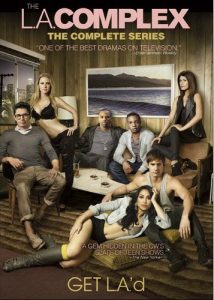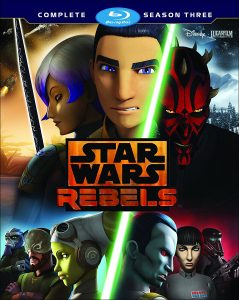Now in its third season, “Star Wars Rebels” (8:30 p.m. Saturdays on Disney XD) has almost entirely caught up to “The Clone Wars” in production value. Even though Disney is spending less money than Lucasfilm did, the animated library of elements is now vast enough to give “Rebels” a more vibrant look, while still retaining the concept that the Ghost crew is operating on the fringes. Also, with the excellent character work done in the back half of Season 2, I like the crew of the Ghost and I care what happens to them. In the first three episodes of Season 3 (“Steps into Shadow” Parts 1 and 2 and “Holocrons of Fate”), “Rebels” keeps the momentum going.
Explaining the high quality, these Season 3 kick-off episodes are written by “Clone Wars” veterans (Steve Melching, Matt Michnovetz and Henry Gilroy), and they get into serious Jedi-and-Sith territory. Making Kanan (Freddie Prinze Jr.) blind at the end of Season 2 has helped viewers understand the idea of the Force as a sixth sense. Ezra’s (Taylor Gray) shorter hair calls to mind Obi-Wan from “Episode I” (minus the Padawan braid) and signals that he’s an apprentice who is moving forward in his Jedi studies. (It also eliminates scenes of his long hair failing to blow in the wind, which drew attention to the cheaper production values.)
A creature named Bendu – who represents a middle ground between the light (Ashla) and dark (Bogan) sides of the Force – teaches Kanan about how his fear and aggression is drawing the spider-creatures to attack; once he quashes those feelings, they back off. Bendu feels like a leftover design from “Ewoks” or “Droids,” but in a good way. Unless it has come up in the comics or novels, this is the first use of the aforementioned terms in the Disney canon. They date all the way back to George Lucas’ earliest “A New Hope” drafts, where “Bendu” was part of the term “Jedi-Bendu,” which ultimately became “Jedi.” In the Legends timeline, Ashla (a light-side moon) and Bogan (a dark-side moon) appear in “Dawn of the Jedi.”
Some of the “Clone Wars” carry-overs have left me a bit cold; notably, Ahsoka (presumed dead in the Season 2 finale) is so much more bitter than her younger self (understandably, of course; but I resent that we didn’t get to see the journey). I like Rex (Dee Bradley Baker), but feel like I’m missing something in his arc, too. But Hondo Ohnaka (Jim Cummings) is always entertaining as a pseudo-ally — here, we learn that he speaks Ugnaught.
And I have to admit that Darth Maul (Sam Witwer) is really working for me. While it stinks that there’s a gap in his narrative, his emotional arc feels complete – he’s gone from simmering rage in “Episode I” to insanity in “The Clone Wars” to a mix of controlled anger and brilliant manipulation in “Rebels” as he aims to acquire our heroes’ Jedi and Sith holocrons.

One area where these episodes skimp a bit is Ezra’s relation to the Sith Holocron. We do see Ezra behaving darkly, as when he prompts an Imperial walker to shoot stormtroopers and walk off the edge of a platform on a Bespin-like planet, so I suppose we can assume manipulation of those troops’ minds is a dark-side act. That’s a somewhat tenuous explanation, though, as this is war, the Empire is evil and it’s hard to imagine what even the purest Jedi — say, Yoda or Obi-Wan — would have done differently. Both of them, along with Luke, kill sentient beings regularly in their roles as warriors.
These early Season 3 episodes ratchet up the tie-ins to the wider “Star Wars” mythology. “Holocrons of Fate” ends with Ezra having a vision of the future when he and Maul bring the two holocrons together. Among the vague images is a place with “twin suns.”
“Steps into Shadow” is more straightforward: It shows the Ezra-led mission to acquire some old Y-wing bombers from an Imperial salvage yard. As Hera (Vanessa Marshall) notes at episode’s end, these ships will go to General Dodonna; these are the Y-wings later used in the Battle of Yavin. The idea that Y-wings are old Republic ships is a bit sketchy, as we never see them used in the Clone Wars, but I suppose that’s something that comics or novels (maybe the “Ahsoka” book) could address down the road.
The most hyped-up part of “Steps into Shadow” is the addition of Grand Admiral Thrawn to the Imperial ranks and the Disney-canon ranks. Lars Mikkelsen does a good job with Thrawn’s smooth-but-alien voice, and his traits are in step with what we’ve known from the Timothy Zahn books – Thrawn thinks several moves ahead, like a chess player. Much to the bafflement of more simple-minded officers, Thrawn lets the Rebels escape with their Y-wings at the arc’s end, as the Ghost fits into a grander scheme.
In a broader sense, I have a problem with the addition of Thrawn to the Disney lore. One of the reasons cited for rebooting the timeline was to give writers a fresh slate. But now they just grabbed a character wholesale from Legends. Thrawn’s status and actions in “Steps into Shadow” would fit with the Legends timeline; I can imagine he’s the guy who goes on to lead the Imperial military in the aftermath of the Battle of Endor.
Indeed, “Rebels” would be so much cooler if it was part of Legends. So far, the TV series hasn’t extremely contradicted any of the lore from that timeline. But, of course, this is not the Thrawn who goes on to grander status — his “Rebels” arc might mark the height of his achievements in the Disney timeline — and that tempers my enjoyment of his inclusion.
Executive producer Dave Filoni and the “Rebels” team are in an awkward position. Their audience is old fans of “The Clone Wars” and new fans of “The Force Awakens,” two cohorts that don’t have a lot of overlap. Sometimes I feel like he’s making a continuation of Lucas’ saga on the sly, which is both admirable and strange. As it goes forward, though, “Rebels” will likely tie in more with Disney’s movie projects, notably “Rogue One,” a December film that seems like it will explore the Rebels’ acquisition of the Death Star plans.
Unavoidably, “Rebels” will always feel slightly hollow because it’s not part of the grand Legends narrative, and instead builds toward Disney’s bland, child-friendly post-“Episode VI” storytelling. But among the “Star Wars” projects Disney is putting out, it’s the cream of the crop, and my curiosity about what Filoni & Company are doing keeps me coming back.

